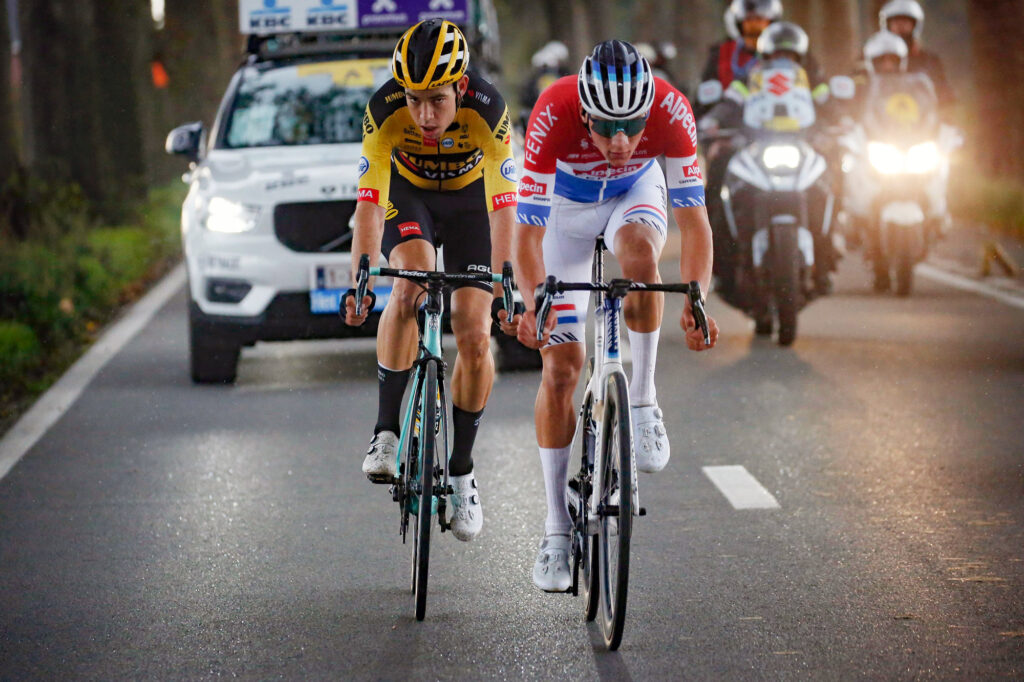Words by Jeremy Whittle | Photos by SWpix.com/Cor Vos
“MOTORCYCLE!” bellowed the TV commentator in angry and accusatory tones, as slow motion replays captured Julian Alaphilippe catapulting off an in-race motorbike and slamming onto the Flandrian concrete, just as the 2020 Tour of Flanders neared its climax.
It was a devastating and shocking crash, and one that changed the course of this year’s rescheduled edition of the Ronde. As he lay injured on the road, TV microphones caught the world champion writhing and screaming in pain, as panicking race officials and medics gathered around him. His companions in the decisive break, Wout Van Aert and Matthieu Van der Poel, glanced back briefly, but they only had eyes for each other and rode on, to contest a nerve-wracking sprint finish.
Their duel, which first began many years ago on the muddy and wintry cycle-cross courses of Northern Europe, was the centre piece off this year’s Ronde and sated the media hype over their frosty relationship, that had been growing in the build-up to the race, and that was further fuelled by deprecating comments the pair had made in the past few days. It was, not unexpectedly, Van der Poel, who followed in his father’s wheeltracks, to sprint to victory, just as his Dad Adrie had done in 1986, while — coincidentally wearing the same race number — 51.

By that time, Alaphilippe’s misfortune had been blamed by most on the hapless moto pilot, but this was one in-race collision that to many eyes was also down to rider error, rather than bad driving. Those who pointed out that the world champion had been looking down speaking into his radio and had missed Van Aert and Van de Poel moving out and passing the motorbike, were quickly shouted down.
The motorbike, a race jury bike following a Shimano neutral service bike that was allowing the leaders to pass, had been in the wrong place, on the inside of a bend. It had been a “shameful” error by the moto pilot; a “serious” mistake; “amateurish” and, said Alaphilippe’s team boss, Patrick Lefevere, the jury bike should categorically not have been there. Others however, maintained that it was a straight section of road.
Nobody underestimates Alaphilippe’s brilliance and his bike handling skills, but his most recent performances have been eccentric. There was the now infamous premature salute and zig zag sprint that cost him Liege-Bastogne-Liege, the miscalculation with an illegal bidon feed at the Tour de France, and another arms-in-the-air-too-soon moment at Brabanste Pijl.
The Frenchman’s dashing characteristics were again on full display in Flanders: the bravado and attacking style that thrills fans and floors opponents came to the fore on the Koppenberg where his first accelerations split the favourites and then, a little further on, when he attacked again on the Steenbeekdries.
There’s little doubt that, on a day of bizarre crashes, his own painful body slam — which left him with broken bones in his right hand and plenty of bruising — robbed the race of what would have been a gripping three way battle.
He was the 2020 Ronde’s Great Catalyst, the force of nature that forced Van Aert and Van der Poel to show their hand. There’s little doubt that, on a day of bizarre crashes, his own painful body slam — which left him with broken bones in his right hand and plenty of bruising — robbed the race of what would have been a gripping three way battle. Alaphilippe would have been a huge influence on the final outcome, which, with him jumping around in the final kilometres, might have been very different.
Yet to these eyes there were two telling moments in the crash: the first, Alaphilippe dropping his gaze from Van Der Poel’s back wheel a nano-second before the Dutch rider moved out of the Moto’s slipstream and passed it; the second, Van Der Poel’s disbelieving shake of the head, as he glanced back and saw the Frenchman prone on the road.
On Sunday evening, his Elegant Quick Step team released a statement: “Julian Alaphilippe crashed into a motorbike and had to abandon the race. The World Champion was taken to the hospital in Ronse, where the X-rays showed fractures of the metacarpal 2 and 4 on his right hand,” it said.
Race vehicles — cars and motorbikes — have, deservedly, been blamed in the past for many accidents. At times there are far too many of them close to the riders, and at times they struggle to get in position, to stick to the right line and to keep their distance. There are plenty of examples of rogue cars and motorbikes, driven badly and taking out riders mid-race — think Johnny Hoogerland in the 2011 Tour de France, Peter Sagan in the 2015 Vuelta, Greg Van Avermaet in the 2015 San Sebastian Classic.
But every now and then the riders have to accept that even they, for all their incredible skill, may have made a mistake, that they may have got it wrong. And that’s not to excuse the culpability of motorbike or car pilots, but merely to state that even drivers with 25 years of in-race experience get it wrong some times — even sports directors, many of whom are themselves ex-pros, can make mistakes.
None of that however, is of any solace to world road race champion Alaphilippe or his team, who for the second time this month, missed out on victory in one of the sport’s most coveted Monuments.

